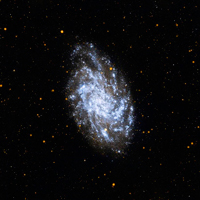Feature Story
NASA's Galaxy Evolution Explorer in Standby Mode
NASA's Galaxy Evolution Explorer, or Galex, was placed in standby mode today as engineers prepare to end mission operations, nearly nine years after the telescope's launch. The spacecraft is scheduled to be decommissioned -- taken out of service -- later this year. The mission extensively mapped large portions of the sky with sharp ultraviolet vision, cataloguing millions of galaxies spanning 10 billion years of cosmic time.
The Galaxy Evolution Explorer launched into space from a Pegasus XL rocket in April of 2003. Since completing its prime mission in the fall of 2007, the mission was extended to continue its census of stars and galaxies.
The mission's science highlights include the discovery of a gigantic comet-like tail behind a speeding star, rings of new stars around old galaxies, and "teenager" galaxies, which help to explain how galaxies evolve. The observatory also helped confirm the existence of the mysterious substance or force known as dark energy, and even caught a black hole devouring a star.
The California Institute of Technology, Pasadena, Calif., leads the Galaxy Evolution Explorer mission and is responsible for science operations and data analysis. NASA's Jet Propulsion Laboratory, also in Pasadena, manages the mission and built the science instrument. The mission was developed under NASA's Explorers Program, managed by the Goddard Space Flight Center, Greenbelt, Md. Researchers sponsored by Yonsei University in South Korea and the Centre National d'Etudes Spatiales (CNES) in France collaborated on this mission. Caltech manages JPL for NASA.




